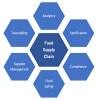Industry
The status quo is changing for most industries as boundaries blur between fields due to innovation, disruption, and digitally-driven change. That’s why keeping abreast of emerging trends in sectors outside your own is vital, not only because your organization’s competitive landscape may be changing, but because there are universal, strategic lessons to learn from the opportunities and threats convergence poses for every marketplace. We examine emerging trends and the impact of evolving tech in key fields such as healthcare, financial services, telco, energy, mobility, and more to help you capitalize on the possibilities of the future while managing the challenges of today.
Recently Published
Business architecture is valuable to all organizations, regardless of type or size. This Executive Update discusses how nonprofits and small organizations can leverage business architecture and articulates some considerations for architecting within these types of environments.
Compared to software, industrial delivery takes longer, is more complex, and requires a broader set of skills. This series on industrial Agile opens with an overview of a framework for industrial agility, and considers these questions:
-
What is new in industry when Agile principles are applied?
-
How do the different frameworks of Lean, Agile, Scrum, and Six Sigma fit together?
While cash still has its place in society, we cannot ignore the growing digitization of money. If digital forms of commerce simplify users’ lives and make it easier for customers to get what they want, when they want it, we can expect to see a much more rapid migration toward merchant mobile applications.
Blockchain has the potential to transform and disrupt the food and retail industries. Giving access to real-time, auditable, trustworthy information on an immutable ledger about the origin, processing, and handling of food will change how consumers make purchasing decisions, level the playing field for high-quality products, and enable new possibilities in consumer, inventory, and supply chain analytics.
By implementing a service platform, our case study company combined complementary capabilities and resources from its existing business with insurtech capabilities — an essential part of the digitization of the insurance company.
The hunt for a suitable insurtech, which not only brings the desired business value to the table but is also the least painful to align with from an IT perspective, needs to be approached in a systematic manner.
Andrew Guitarte describes the paradigm of big data analysis and how it “shifts from manual to automated, dependent to autonomous, isolated to context-aware, product-driven to needs-based, batch to real-time, and static to streaming.” This paradigm shift is important especially in the context of automated wealth advisory services where the organization of otherwise unstructured data is vital. His article takes us into the realms of business capability architecture (BCA) and presents a cognitive and heuristics-based emergent financial management (aka CHEF) tool that can be used effectively in emergent decision-making processes of bank employees, shareholders, and their customers.
Insurtechs are not going away, so it is essential for incumbents to strategize and leverage the insurtechs to address those areas considered important by customers and where the insurtechs add significant value (e.g., advanced analytics, enhanced customer experience). At the same time, it is critical that small and medium-sized insurance companies ensure that any investments made will deliver expected results and de-risk themselves to the desired extent. To achieve these goals, the incumbents need to develop a clear strategy to guide their engagement with insurtechs, beginning with a holistic approach.












